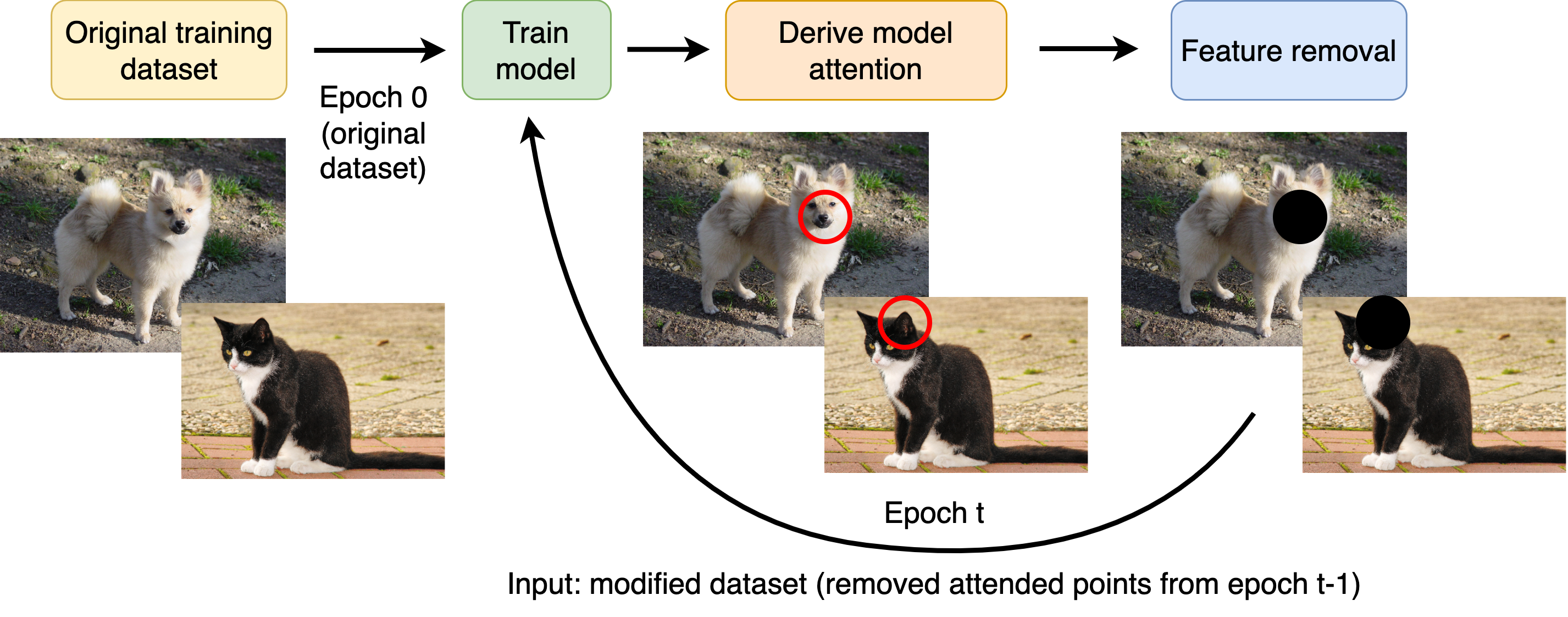Convolutional Neural Networks (CNNs) have found extensive application in recent years. While they are very successful on large benchmark datasets, training on small and noisy datasets is still challenging. A particular problem is so-called “shortcut learning” [1], where models only learn to classify data based on a very limited set of features; just sufficient to achieve high performance on the train data, but not enough to generalize to unseen data. A common strategy to tackle this issue is data augmentation, e.g., cropping or rotating images randomly to make the data more diverse [2, 3]. Here, we suggest a more targeted strategy: Instead of randomly changing the image, the dataset should be modified based on the model’s attention. Consider the following example: a model should learn to distinguish dogs and cats, and it has learnt to distinguish dogs just by the shape of their ears (shortcut learning). To “encourage” the model to learn other features as well, one could blur or cut the dogs’ ears out of the images. In the next epoch, where the input are the modified dog images, the network hopefully learns to distinguish dogs based on other features, e.g. from the tail. Since specific features are removed in this training scheme, we call this idea “Featout”. A schematic representation of the idea is shown below.
Implement a simple version of a “Featout” pipeline and demonstrate it on an image dataset! The goal of the project is to show superiority of Featout over normal training on a selected dataset. To do so, you need to implement the Featout method (see below for starting code), and select a dataset for training and testing where targeted data augmentation is of advantage. For example, you could make a table / figure reporting the test data accuracy for normal training and for the featout training pipeline.
While you are free to choose methods, you should stick to the basic idea of modifying the training dataset based on the model’s attention. You need to select 1) the dataset, 2) the model architecture, 3) methods to derive the model’s attention, and 4) methods to modify the input data. Some hints on each of these points:
- Dataset: Think about when the Featout method could be most successful. In particular, it might not make sense to use a super large dataset that already covers very diverse samples for each class. Also, you could try to demonstrate that Featout helps to generalize to different data (make the test data significantly different from the training data, e.g. different light / blur)
- Model: Probably, any architecture should be fine, but some model architectures support interpretability
- Model attention: Note that the model’s attention must be derived efficiently. Since the dataset should be modified during training, a method with too much computational effort is not feasible. Thus, gradient-based methods are most suitable (this repo uses a simple gradient saliency method, see here)
- Feature removal: The idea is to prevent the model from learning the same features in the next epoch. It is up to you how to do this. In this repo, the parts of the image with most attention are either blurred or masked with zeros (see here)
Submit a link to your GitHub repository, where the README file should describe your approach. Feel free to submit further material, such as plots, images or other results.
For inspiration, we provide a codebase with a simple implementation of Featout in this repository. In the folder “papers”, you can find some related work. The one that is most related to the Featout idea is the paper by Wang et al [4] proposing a method called CamDrop (they use class activation maps to get the models attention and then drop the neurons at the points of highest activation).
The required packages are listed in the requirements file.
You can install this repository and all required dependencies in a virtual environment by running
git clone https://github.com/NinaWie/featout.git
cd featout
python -m venv env
source env/bin/activate
pip install -e .
Then, you can run the training with a simple featout-pipeline by executing the following:
python train_featout.py
This will train for one epoch and then start FEATOUT. At the core of this codebase is the Featout dataset, a torch Dataset class that applies featout in the __getitem__ method. In other words, everytime that a new batch is sampled, the __getitem__ method from this dataset is called. If featout is activated (class attribute featout=True), then the method applies an attention mechanism to find the features with highest activation, and blurs the feature.
NOTE: The same code is provided in a jupyter notebook, if you prefer notebooks or want to use it in colab
At first, make sure that you understood the main idea, and have a short look at the papers. Then, you can but don't have to start from this repository. Maybe you would like to work with tensorflow or just want to implement your own pipeline - that is totally fine! In that case, the first step would be to select a dataset and model and make a normal CNN pipeline work. Maybe test whether standard Dropout improves the results. Then, implement the featour idea (find a suitable method to remove features from the data based on the model's attention).
If you start from the code in this repository, first familiarize with the code of the featout dataset. This code is quite central and uses other functions in this repository, such as the code for blurring the feature or the function for interpreting the model's attention. Run the code with python train_featout.py. You can also plot some examples by setting PLOTTING_PATH="outputs" in the script (hard-coded). This will save examplatory images to a new folder named outputs (it will save a lot of figures, so don't run this for a lot of epochs). Then, once you have an understanding of the existing code, try to use another dataset, or implement other model-attention methods or other feature-deletion-methods.
